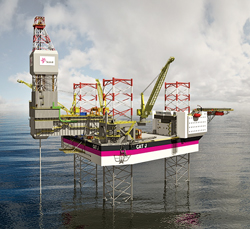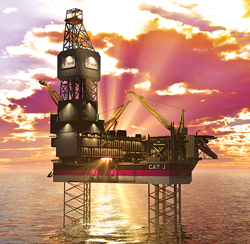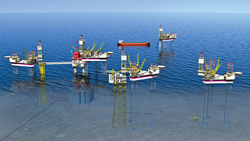|
Statoil is preparing an invitation to tender for a new type of drilling rig for mature fields on the Norwegian continental shelf (NCS). The new rigs, known as category J, will be jack-ups designed by the industry on behalf of Statoil. The purpose is to make drilling and completion of production wells less expensive, more efficient and safer.
In order to realize the full potential of the NCS and boost oil recovery, Statoil wants to increase drilling on mature fields. Lower rig rates, greater drilling efficiency and access to rigs are key factors to meet this challenge. The new rig concept is designed to meet these requirements. Ultimately, the desired goal is that the new rigs will perform operations 20% more efficiently than conventional rigs. This should reduce field development costs while rejuvenating the rig fleet.
“The key to maintain today’s production level on the NCS towards 2020 is improved recovery from existing fields and fast and effective development of new fields. We need to drill more wells to deliver on our production ambitions,” says Øystein Arvid Håland, head of drilling and wells at Statoil.
NEW TAILOR-MADE RIGS
The new category J rigs will be able to operate at water depths from 70 to 150 m and drill wells down to 10,000 m. It will be a workhorse primarily for drilling and completion of production wells. It is a tailor-made jack-up rig for operations in harsh environment on both surface and subsea wells in the shallow-water segments on the NCS. “Statoil has the capacity and competence to drive technology and innovation,” says Håland.
TECHNICAL CAPABILITIES
Hull designers, topside suppliers, construction yards and drilling contractors have participated in the development of the Cat J rig concept and will continue to develop this in an innovative design process. The Cat J conceptual design has the following key elements:
-
Competitive operational cost compared with existing rig fleet
-
More efficient drilling with quadruple derrick.
-
Minimum weather downtime due to vessel motion in operation.
-
Low diesel consumption cost
-
Lower wellhead fatigue exposure
-
High flexibility for efficient drilling over wellhead platforms and subsea field development
-
Early production drilling on new field development projects
The main features of the new cat-J design will include:
-
GustoMSC CJ70-X150 concept based on proven technology and equipment from Aker Solutions, National Oilwell Varco or TTS
-
Test/service BOP and christmas tree on cellar deck
-
Facilities for new fast-track christmas tree size and system
-
1.5 derrick—simultaneous drilling and building stands
-
Trip-saver function—possible to hang off blowout preventer (BOP) and riser (250 tonnes) on Texas deck.
-
Designed for Statoil’s subsea system on the NCS.
-
X-Y skidding cantilever 110-ft reach
-
BOP riser tension systems designed for both surface and subsea BOP operations
-
High-pressure, high-temperature (HPHT) operations (15,000 lb)
-
Up to 150 m water depth
-
Class Notation: DNV 1A1 self-elevating unit and drilling unit
|



|
| Statoil has released several design concepts for its Cat-J rigs that are customized for efficient operations on the Norwegian Continental Shelf. The rigs are scheduled for delivery during the second half of 2015. |
|
HSE REDUNDANCY
The philosophy behind the Cat J design is based on a double barrier to prevent falling objects and ensure well control. The design should prevent environmental spills and assure an improved working environment. Statoil envisions a high level of redundancy in material handling, crane coverage, and pipe handling, as well as power generation and control systems.
COST REDUCTION THROUGH OWNERSHIP
“Statoil is working continuously to secure a rig fleet with the right capacities and capabilities to suit our needs. However, upgrade and adaptations on many of the existing rigs appear too costly for our requirements and challenges on the NCS. We are, therefore, taking steps to rejuvenate the rig fleet and ensure that the right rigs meet the right requirements,” says Jon Arnt Jacobsen, chief procurement officer in Statoil.
“Now we are following up our industrial approach by proposing to take ownership of the rigs through licenses to improve economics further. As a long-term industrial player on the NCS, we look forward to working with suppliers who have competence in building and operating rigs to develop new and cost-effective solutions,” says Jacobsen.
Statoil plans to tender for at least two Cat-J rigs in July 2012 and to award contracts in the second half of 2012. The rigs are to be delivered in the second half of 2015 and will be working on mature oil and gas fields offshore Norway soon after.
CONSTRUCTION
To reduce risk and secure yard capacity when the contracts are awarded, Statoil has reserved slots and critical steel at five different construction yards:
-
Daewoo Shipbuilding & Marine Engineering Co. Ltd, Korea.
-
Samsung Heavy Industries, Korea.
-
Hyundai Heavy Industries, Korea.
-
Keppel FELS Ltd., Singapore.
-
Jurong Shipyard Pte., Singapore.
Each of the yards have proven HSE and construction records and should be able to build the rigs within the expected delivery time. 
|





